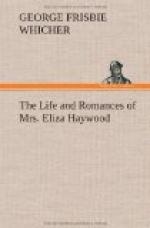“Euph. Mr. Pope was severe in his castigations, but let us be just to merit of every kind. Mrs. Heywood had the singular good fortune to recover a lost reputation and the yet greater honour to atone for her errors.—She devoted the remainder of her life and labours to the service of virtue.... Those works by which she is most likely to be known to posterity, are the Female Spectator, and the Invisible Spy....”
CHAPTER VI
LETTERS AND ESSAYS
The works of Mrs. Haywood’s maturity most renowned for their pious intent were not of the tribe of novels, but rather in the shape of letters or periodical essays such as “Epistles for the Ladies” (1749) and “The Female Spectator” (1746). Each of these forms, as practiced during the eighteenth century, permitted the introduction of short romantic stories either for the purpose of illustrating a moral or to make the didacticism more palatable. Even as a votary of virtue Eliza did not neglect to mingle a liberal portion of dulce with her utile; indeed in the first of the productions mentioned she manifested an occasional tendency to revert to the letter of amorous intrigue characteristic of her earlier efforts. In her latest and soberest writings, the conduct books called “The Wife” and “The Husband” (1756), she frequently yielded to the temptation to turn from dry precept to picturing the foibles of either sex. Her long training in the school of romance had made gallantry the natural object of Eliza Haywood’s thoughts.
During the time that she was incessantly occupied with short tales of passion she had experimented in both the letter and the essay form, using the former especially as an adjunct to her stories. One of her first attempts, also, to find her proper vein as an author was a translation from the French of the “Letters from a Lady of Quality to a Chevalier,” with a “Discourse concerning Writings of this Nature, by Way of Essay” for which the translator was responsible. In “The Tea-Table” (1725), which never advanced beyond the second part, and “Reflections on the Various Effects of Love” (1726) the then well-known novelist returned to the essay form, and a comprehensive volume of “Love-Letters on All Occasions” (1730) closed the first period of her literary activity. But none of these departures was noticeably different in tone from her staple romances.
The sweets of love were perhaps most convincingly revealed in the amorous billets of which “Love in Excess” and many of Eliza’s subsequent pieces of fiction contained a plentiful supply. Letters languishing with various degrees of desire or burning with jealous rage were introduced into the story upon any pretext. Writing them was evidently the author’s forte, and perusing them apparently a pleasure to her readers, for they remained a conspicuous part of Mrs. Haywood’s sentimental paraphernalia.




